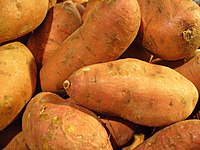
Photo from wikipedia
To meet the high demand for white Guinea yam, there is a need to develop and release improved varieties to farmers. Unfortunately, low rate of adoption of most of the… Click to show full abstract
To meet the high demand for white Guinea yam, there is a need to develop and release improved varieties to farmers. Unfortunately, low rate of adoption of most of the improved yam varieties by both producers and consumers was observed. Information regarding agronomic characteristics and food qualities of popular white Guinea yam landraces with high market value are not available to establish minimum standards to be considered by breeding programs. To fill this gap, surveys using rural appraisal tools were carried out in 20 villages and 16 markets throughout Benin. Data on the agronomic performance suggested that for an improved variety to be adopted by Beninese farmers it should have a minimum yield of 4.16 ± 0.15 kg per mound, and average number of marketable tubers of 1.23 ± 0.05, a mean tuber length of 36.41 ± 1.22 cm, and a minimum diameter of 25.44 ± 1.16 cm. The sensorial attributes for boiled and pounded tubers of this improved variety should have minimum score of 3.16 for texture, 0.75 for softness, 3.75 for elasticity, and 1.34 for colour during the sensory evaluation. The improved variety must also have a minimum average severity score of 1.1 for yam mosaic virus disease, 1.33 for anthracnose and 1 for nematodes. Landraces Amoula, Laboko, and Djilaadja should be considered as the standard for yield, sensory attributes, and tolerance to pest and diseases while landraces Danwari, Kodjewe, Mondji, and Gnidou should be characterized as possessing good flowering and fruit setting capacities for breeding programs.
Journal Title: PLoS ONE
Year Published: 2022
Link to full text (if available)
Share on Social Media: Sign Up to like & get
recommendations!